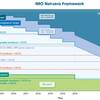With a 7.2 percent increase in overall turnover Germany¹s largest seaport is
also positioning itself in front of other Northern European all-purpose
ports. In the first six months of 2003 the other ports achieved an average
handling increase of 5.8 percent.
In the first six months a total volume of 51.3 million tons of seaborne
cargo was loaded and unloaded at the Port of Hamburg's cargo handling
terminals. This represented an increase of 7.2 percent compared to the same
period last year. While bulk cargo handling increased by a negligible 0.7
percent, the 11.5 percent increase in LCL turnover brought a volume gain of
3.3 million tons.
In the first half of 2003 a record 2.9 million TEU's (20-feet equivalent
unit) were handled at the Hamburg Container Terminals. This represented an
increase of 14.9 percent compared to the same period last year. This means
that, for the fifth year in succession Hamburg can show a double-figure
increase in container turnover. The increase in container handling since
2000 was clearly over the average growth-rate for the ports in Northern
Europe (Bremen/Bremerhaven, Rotterdam and Antwerp). "This allowed Hamburg to
increase its market share," said Dr. Juergen Sorgenfrei, Chairman of Port of
Hamburg marketing(HHM).
"The positive development in Hamburg's Far East container traffic has been
only slightly impaired by the SARS epidemic," he added.
The 23.4 percent increase in Far East container traffic decreased briefly to
19.6 percent during the second quarter due to the effects of the SARS
epidemic. Overall container traffic in this area a particularly important
one for Hamburg increased by a clear 21.4 percent in the first half of the
year.
"Hamburg's position as the port with the largest quantity of traffic to and
from China remains unchanged. One new development is the fact that Hamburg
is now becoming the most important seaport for all the OFar East shipping¹
shipping area in northern Europe," said Dr. Sorgenfrei.
In the South and Southwest Asian shipping areas increases of between five
and 10 percent were also recorded. Container traffic with the Indian
Subcontinent in particular increased by a clear 11.3 percent. New and
revamped scheduled services will bring further growth in the second half of
the year.
North American traffic on an upswing high growth-rates in South American
traffic
After the slight decreases in business on the North American East Coast and
Canadian trading routes were recorded in the first quarter of 2003, more
cargo was handled in the second quarter than in the same period last year.
In the first half of 2003 Hamburg's North American container turnover
increased by 0.8 percent.
The first half of 2003 brought an increase in container traffic with the
east and west coasts of South America of 12.5 percent and 13.3 percent
respectively. Because of the crisis in Argentina exports to South America
remained lower than imports from that region. Imports increased strongly
following the devaluation of the Brazilian Real and the Argentinian Peso.
New scheduled services from Hamburg had already been established by
mid-2002.
Hamburg expands its position as Europe's main port for the Baltic Sea region
Along with new scheduled overseas container services, countless new feeder
services were also started from Hamburg to the Baltic Sea region in the
first half year. The Combisped Container Terminal in Lübeck (CTL) also
commenced operations during the same period. "Hamburg's position as the most
important hub and assembly point for Baltic freight was further upgraded and
it also increased its decades-old cutting edge in Scandinavian traffic,"
said Dr. Sorgenfrei.
In the first six months of 2003 container traffic with Scandinavia achieved
an increase of 15.2 percent. Container traffic via Hamburg with the rest of
the Baltic Sea region (Finland, Russia, the Baltic States and Poland) even
achieved an increase of 27.1 percent. The export boom to Eastern Europe
recorded last year is continuing this year as well. Seawards trade to and
from Eastern Europe provided the highest growth in all shipping areas with
increases of 27.1 percent in the first half of the year.
A significant portion of the increase is due to the continued rise in
traffic with the Russian Federation. The Russian Federation now occupies
sixth place on the list of "Hamburg's Ten Most Important Trading Partners".
In the first half of the year some 125,000 TEU's were processed in both
directions (+19.1 percent).
Conventional Cargo Handling Decreases
The relocation of the departure point for the ferry to England from Hamburg
to Cuxhaven at the beginning of 2002, the closing of the Cellpap Forest
Products terminal at the end of 2002 and the dissolution of the Harms Car
Feeder Service in 2003 are cited as the reasons for the drop in conventional
cargo traffic, which decreased by 16.1 percent in the first six months of
the year. Some other causes of the drop in handling quantities in this area
were the poor sugar beet harvest, which led to low sugar production, the
civil war in West Africa and the effects of the war in Iraq.
Nevertheless, important imported goods include tropical fruit, non-ferrous
metals, paper and cellulose. Significant product groups in shipments of
conventional freight included iron and steel products, project cargo and
motor vehicles. A new scheduled service which has been carrying bananas from
South America to Hamburg since the beginning of the year, the Pearl String
Service of the Rickmers Line was started in April. More new services were
started in July and August.
Hamburg's bulk cargo traffic set to increase
In the area of bulk cargo a total of 19.3 million tons of freight was
handled in the first half of 2003 at the special terminals for grab goods,
suction goods and liquid cargo. This corresponds to an increase of 0.7
percent.
Handling of grab goods increased by 1.2 percent and achieved a total volume
of 10.3 million tons. Significant products in this area are imported coal
and ore.
The handling of liquid cargo grew compared with the same period last year
and showed an increase in handling volume of 5.7 million tons, which
corresponds to an increase of 0.6 percent. Imports of mineral oil products
in particular increased during the last four months and with a volume of
642,000 tons showed the highest level since March 1999.
The 3.3 million tons of suction goods handled was just one percent under the
result for last year.
Port of Hamburg Marketing also expects a distinct increase in seawards cargo
handling for the second half-year period
"Due to its favorable geographic location for transport Hamburg benefits
from the growing Far East and Baltic Sea traffic movements in particular.
The wide range of transport services offered by various modes for rapid and
short pre- and on-carriage to domestic markets unique in Northern Europe
makes Hamburg a central seaport and a central foreign trade distribution
center," said Dr. Sorgenfrei.
In addition, a new series of scheduled services ensures an increase in
volume in Germany's largest logistics center, "The Port of Hamburg".
Sponsored Content
Experience Custom Yacht Signs and Designs Tailored to Perfection!

Subscribe for
Maritime Reporter E-News
Maritime Reporter E-News is the maritime industry's largest circulation and most authoritative ENews Service, delivered to your Email five times per week











